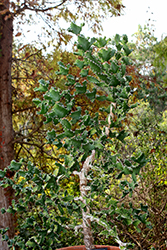Fri & Sat 8am - 8pm
Sun 8am - 7pm
Anytown, USA 12345
fax: 261.787.0463
e-mail: info@successgc.com


Plant Finder

Monstrose Euphorbia
Euphorbia lactea var. monstrosa
Height: 4 feet
Spread: 3 feet
Sunlight:
![]()
Hardiness Zone: 10a
Other Names: Monstrose Mottled Spurge, Dragon Bones
Description:
An unusual, bold plant for a sunny area; twisting, undulating, free form branches and crests form on a widely variable habit; flower bracts are showy at branch ends; adds a truly exotic and otherworldly dimension to the garden or containers
Ornamental Features
Monstrose Euphorbia is a highly distinctive and unusual plant. Although it actually isn't technically a cactus, it is still a succulent evergreen which behaves much like a cactus. It is characterized by the highly modified and distinctive rough cylindrical bluish-green stems that comprise the bulk of the plant, and which are designed to retain water for extended periods of time. It has green evergreen foliage. The succulent leaves remain green throughout the winter. This plant features dainty clusters of red flowers held atop the branches from late winter to mid spring.
Landscape Attributes
Monstrose Euphorbia is an unusual succulent evergreen plant with an upright spreading habit of growth. It commonly grows as a shrub-like plant with multiple 'branches' and stems. Unlike a cactus, which this plant resembles, it does have foliage, but it's the rough bluish-green narrow cylindrical segments that are of primary interest from a landscape or garden perspective.
This is a relatively low maintenance shrub, and should not require much pruning, except when necessary, such as to remove dieback. Deer don't particularly care for this plant and will usually leave it alone in favor of tastier treats. Gardeners should be aware of the following characteristic(s) that may warrant special consideration;
- Spiny
Monstrose Euphorbia is recommended for the following landscape applications;
- Accent
- Mass Planting
- General Garden Use
- Container Planting
Planting & Growing
Monstrose Euphorbia will grow to be about 4 feet tall at maturity, with a spread of 3 feet. It has a low canopy. It grows at a slow rate, and under ideal conditions can be expected to live for 40 years or more.
This shrub should only be grown in full sunlight. It prefers dry to average moisture levels with very well-drained soil, and will often die in standing water. It is considered to be drought-tolerant, and thus makes an ideal choice for xeriscaping or the moisture-conserving landscape. Like most succulents and cacti, this plant prefers to grow in poor soils and should therefore never be fertilized. It is not particular as to soil pH, but grows best in sandy soils. It is highly tolerant of urban pollution and will even thrive in inner city environments. This species is not originally from North America, and parts of it are known to be toxic to humans and animals, so care should be exercised in planting it around children and pets. It can be propagated by cuttings.
Monstrose Euphorbia makes a fine choice for the outdoor landscape, but it is also well-suited for use in outdoor pots and containers. With its upright habit of growth, it is best suited for use as a 'thriller' in the 'spiller-thriller-filler' container combination; plant it near the center of the pot, surrounded by smaller plants and those that spill over the edges. It is even sizeable enough that it can be grown alone in a suitable container. Note that when grown in a container, it may not perform exactly as indicated on the tag - this is to be expected. Also note that when growing plants in outdoor containers and baskets, they may require more frequent waterings than they would in the yard or garden.
